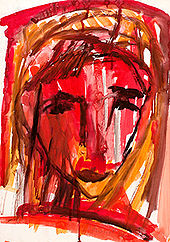Paul Huebner
Paul Friedrich Hübner (born March 20, 1915 in Lörrach ; † August 21, 2003 in Kandern ) was a German painter , poet and writer .
Life
Hübner grew up as the son of a factory worker in Weil am Rhein and Basel . He had to break off his visit to the Lörracher Hans-Thoma-Gymnasium due to lack of money. Instead, after graduating from elementary school, Hübner worked as a chemical laboratory assistant in Basel. At 15, Hübner began to write his first poems, stories and drafts for dramas. In 1934/35, Hübner undertook a study trip to Italy on foot. After his return he married the shoemaker's daughter Gertrud Hedwig Bernhard in 1936 and prepared privately for the Abitur and theology studies. Novellas, poems and dramas were written during this time. In 1938, however, Hübner was called up for Reich Labor , then for military service and then to participate in the war as a soldier. Seriously wounded in Lapland at the end of 1941, he was forced to work as a chemical laboratory assistant in his home country in 1943 and moved to Lörrach. Hübner now turned to painting: After the Second World War, Hübner worked as a freelance painter and writer, then from 1951 as a commercial artist for the Suchard chocolate factory and was finally able to train as a teacher . He practiced this profession from 1953 to 1969 in Lörrach and Holzen . After that, Hübner lived, again as a freelancer, in Kandern.
plant
Although he was self-taught , he was well respected as a painter . He became known to a larger audience in 1947 when he organized an exhibition in Lörrach to revive free art after the National Socialist era and equipped it with other artists and took part in an exhibition at the Baden Secession . His expressive and sometimes non-representational paintings, which are kept in strong colors, were among others. a. exhibited in Baden-Baden , Basel, Freiburg im Breisgau , Munich and Sens (France).
The subject of Hübner's paintings in the 1940s was initially suffering and grief. In the 1950s he turned to religious subjects, but above all to expressive landscape painting and the representation of village and city views, which he retained until the 1970s. In the 1960s, portraits and head views were added in increasingly abstract forms. At the beginning of the 1970s, Paul Hübner finally turned to non-representational painting.
As a writer, Hübner has published several books in poetry and prose . The story From the Wandering Life of T. Balder , published in 1948, was his first work. His Lapland Diary 1941 , published in 1985, received the greatest attention , his secretly written war diary, in which he dealt with the contradiction between the breathtaking beauty of the Arctic landscape and the horrors of war.
Fonts
- From the wandering life of T. Balder, story . Rebmann-Verlag, Loerrach 1948
- The crab , story (under the pseudonym "Paul Friedrich"). In: Die Erzählung (Konstanz), 4, 1950
- In space and time. Poetry and prose . JG Bläschke, Darmstadt 1978
- The mountain , novel. Ried, Kandern 1984, ISBN 3-924567-01-8
- On the question of the essence of man. Casual notes from experiences and intuitions . Ried, Kandern 1984, ISBN 3-924567-00-X
- Lapland Diary 1941 . Ried, Kandern 1985, ISBN 3-924567-02-6
- Poems 1936–1948 . Resin, Binzen 1993, ISBN 3-923066-35-X
literature
- Paul Huebner (1915-1969) . In: Hans H. Hofstätter (Ed.): The painters of the Markgräflerland . Schillinger, Freiburg 2000, ISBN 3-89155-349-8 , pp. 44-45 .
- Huebner, Paul Friedrich . In: Fred L. Sepaintner (Ed.): Baden-Württembergische Biographien . tape 4 . Kohlhammer, Stuttgart 2007, ISBN 978-3-17-019951-4 , pp. 162 (published on behalf of the Commission for Historical Regional Studies in Baden-Württemberg).
- Hermann Glaser : Murder rush and untouchedness . In: The time . June 27, 1986 (Review of the Lapland Diary 1941 ).
- Literature by and about Paul Huebner in the catalog of the German National Library
| personal data | |
|---|---|
| SURNAME | Huebner, Paul |
| ALTERNATIVE NAMES | Friedrich, Paul (pseudonym) |
| BRIEF DESCRIPTION | German painter, poet and writer |
| DATE OF BIRTH | March 20, 1915 |
| PLACE OF BIRTH | Loerrach |
| DATE OF DEATH | August 21, 2003 |
| Place of death | Kandern |



